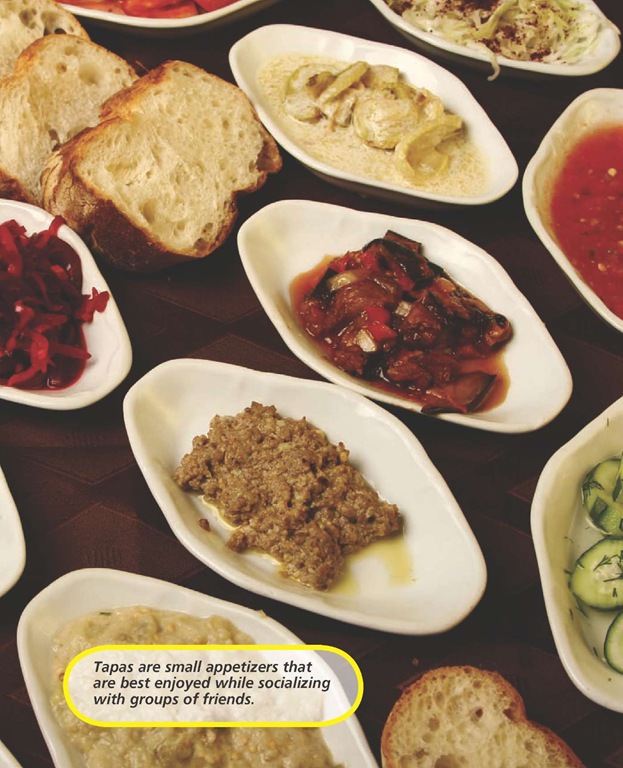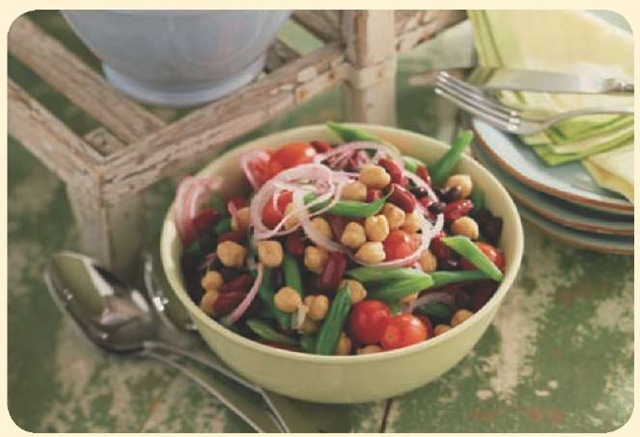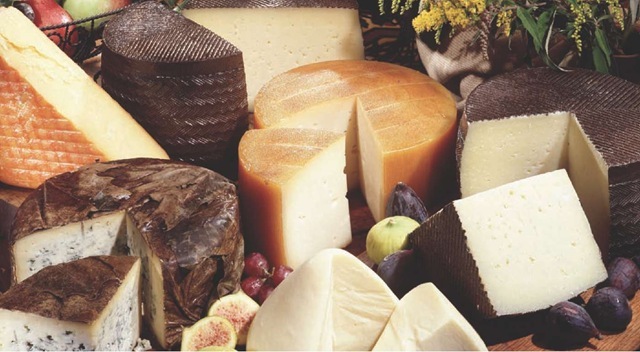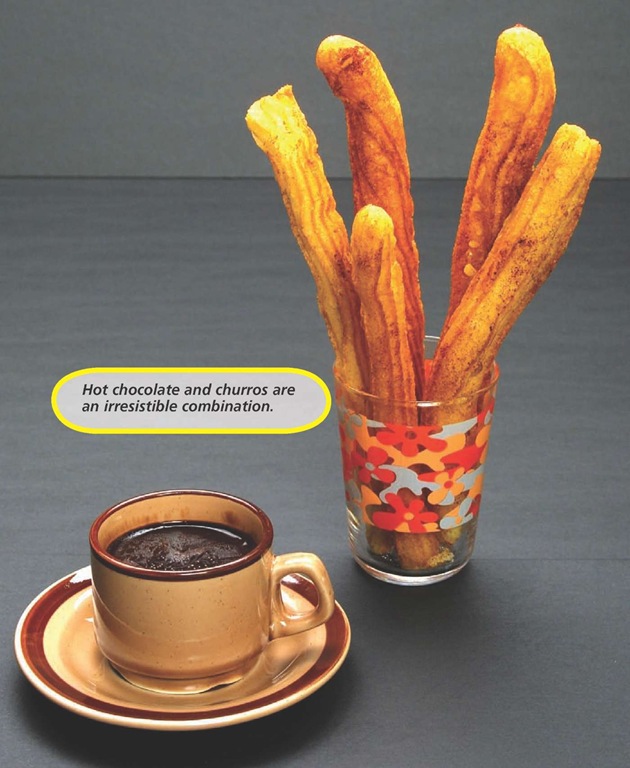Spaniards eat round-the-clock. Breakfast is served around 7 a.m. A few hours later, Spaniards enjoy a midmorning snack. Lunch follows late in the afternoon. Merienda (may-ree-en-dah), a late afternoon snack, and tapas (tah-pahs), an evening minimeal, tide hungry Spaniards over until supper, which is not eaten until at least 9 p.m. Some night owls might even have a predawn snack. On Sundays, Spaniards indulge in special sweet treats.
Sociable Bites
Tapas are bite-sized appetizers that Spaniards adore. These little snacks not only prevent Spaniards from getting hungry during the long stretch from lunch to supper, but they also bring fun-loving Spaniards together.
Eating tapas is one of the most social of all activities in Spain. In fact, meeting friends over tapas is practically a national pastime. Sharing tapas makes sense, since it allows diners to sample a large variety of the little treats. "Congregating to enjoy tapas offers friends and colleagues the chance to eat, to drink . . . and to socialize," says food writer Andrea Greeley. "Besides," she explains, "tapas are best eaten in groups, giving both cook and patron a chance to appreciate innumerable dishes with many different flavors, textures and colors."10
Countless Varieties
A tapa can be as simple as a piece of cheese or as complex as a perfect miniature pie stuffed with seafood. It can be hot or cold, cooked or uncooked. Anything served in a small portion can be a tapa. There are grilled shrimps on banderillas (bahn-day-ree-yas), miniature skewers named for the poles used in bullfighting. And there are tiny fried baby squid that are so small and tender that they can be eaten in one bite, tentacles and all. Also popular are sausages rolled in cabbage leaves, pork rolled in ham, eggs stuffed with salmon, and little round turnovers and pies known as empanadillas (em-pahn-ah-dee-yas). These may be stuffed with tuna fish, sardines, meat, ham, or cheese. There are fried patties made of shrimp, clam, chicken, or even leftover paella. Small chunks of cheese, sausage, or olives wait to be speared with toothpicks or piled on bite-sized sandwiches. Tiny cazuelas are filled with stews, casseroles and soups, or seafood dripping with garlic and olive oil. Chunks of crusty bread are used to sop up the sauce. The choices are almost endless.
Some tascas (tah-scahs), the barlike restaurants where tapas are served, offer as many as 50 different kinds of tapas. Others specialize in a particular type of tapa. Spaniards often go from one tasca to another seeking their favorites. This is known as tasca hopping. But no matter which tapas diners select or where they go to find them, one thing is certain, the tapas are always freshly made right on the premises.
An Informal Place
Tascas are informal places. Spaniards have been coming to them for centuries. The first tascas were dusty roadside taverns where 18th-century travelers stopped for a drink. The tavern keeper often covered the drink with a slice of bread or ham, in order to keep dust and flies out. These bits of food were the first tapas. In fact, in Spanish, the verb "tapear" (tah-pay-are) means to cover.
Modern tascas are equally casual. Some have menus, while others list their fare on a large blackboard or simply spread their offerings on a long bar. Most tascas have a few small tables and chairs. But since they are often extremely crowded, it is common to dine standing at the bar. Friendly Spaniards do not seem to mind the crowded atmosphere.
Marinated Garbanzo Beans
Garbanzo beans, or chickpeas, are popular in Spain. This dish is a common tapa. It is tasty and easy to make. Sliced tomatoes and black olives can be added.
Ingredients
1 can (15 oz.) garbanzo beans
2 tablespoons red wine or balsamic vinegar
1 hard-boiled egg, chopped V cup olive oil
2 tablespoons minced parsley or cilantro
1 tablespoon minced garlic salt and pepper to taste
Instructions
1. Cook the beans as directed on the can. Drain in a colander.
2. Put the beans in a large bowl. Add the remaining ingredients and mix well.
3. Cover the bowl. Refrigerate overnight.
Banderillas
Most anything that can be stuck on a wooden skewer or a toothpick can be a banderilla. Possible choices include an olive, a chunk of cheese, and a red bell pepper square; a piece of melon and a piece of ham; or a chunk of tuna fish, an olive, and a potato cube. This recipe uses shrimp, red pepper, olives, and cucumber. Tuna, ham, or cheese can be substituted for shrimp.
Ingredients
12 bamboo skewers, 6-9 inches in length
12 pimento-stuffed green olives
12 small cooked shrimps
1 red bell pepper, cleaned and cut into chunks
1 cucumber, peeled and cut into 12 rounds
Instructions
1. Put an olive, a shrimp, a pepper chunk, and a cucumber round on each skewer.
Shrimps are only one of the many food items that can be used. If it can be skewered, it can be a banderilla.
The more diners, the more chance for lively conversations. And although tascas are considered bars where adults often drink wine with their tapas, families with children are a common sight. Saveur magazine editor Margo True, who lived in Spain as a child, recalls: "One of the things we’d do . . . was to go out at night and eat tapas with friends. . . . We use to call it tasca hopping, and what fun it was! We’d go into the most promising looking place and sit at a thick wooden table____Then came the tapas, which seemed to me to be proportioned just right for a kid.
Heavenly Treats
Although cookies, cakes, and other pastries are available in bakeries throughout Spain, many Spaniards insist that the best pastries can be found at the country’s 200 Catholic convents. Here, nuns who rarely go beyond the convent’s walls bake and sell sweets in order to help pay for their lives of prayer.
Visitors give their orders at a special window. A nun, who can be heard but not seen, takes the order. The visitor pays for the sweets by placing money on a torno (tor-no), a round spinning tray. The nun spins the torno to get the money and then places the sweets on the torno for the customer.
Spanish nuns have been baking and selling pastries in this manner since the 15th century. Many use ancient recipes that have been passed down in their particular convent but kept secret from the public.
Spain produces many different cheeses made with milk from cows, sheep, or goats.
Sweet Treats
Desserts eaten after lunch or supper are usually quite simple. Fresh fruit, rice pudding, or a baked custard known as flan (flahn) are common favorites. Pastries and sweet breads are reserved for merienda, as well as for breakfast. Sweets are also a frequent treat on Sunday when Spaniards flock to pastry shops to buy tarts and cakes to share with visiting family members.
No matter what the day or the time, hot chocolate is always popular. Spaniards drink it for breakfast, as part of a midmorning snack, in place of coffee or tea for merienda, and as a delicious end to late-night festivities. Spaniards have loved hot chocolate ever since the Aztec chief Montezuma served the Spanish explorer, Hernan Cortes, the drink in 1519. A year later Cortes introduced it to Spain.
Spanish Cheese
A chunk of cheese is a popular tapa. Spain produces about 100 different types of cheese, most of which are unfamiliar ► to North Americans. Spanish cheeses can be made with milk from cows, sheep, or goats.
Manchego (mahn-chay-go), a hard salty cheese made from sheep’s milk, is one of the most well-known Spanish cheeses. Manchego is made in a special mold, which imprints a zigzag pattern on the sides of the cheese. A wooden board pressed on the top adds a wheat pattern.
Cabrales (cah-brah-lays) is another popular cheese. It is a blue cheese made from cow’s milk. It is aged in a cave for three months. This produces the blue veins that run through the cheese and its strong scent.
Mahon (mah-hown) has a sweeter scent. It is also a cow’s milk cheese. It is encased in a waxy red rind, which is rubbed with olive oil. This gives the sharp-tasting cheese a fruity aroma.
Early hot chocolate had a bitter taste, so Spanish cooks added sugar to sweeten it. The resulting drink became so popular that Spanish clergymen worried that it might be addictive. Despite these concerns, by the 17th century drinking hot chocolate had become so fashionable that Spanish royalty often hosted merien-das in which hundreds of guests were served hot chocolate flavored and scented with dried rosebuds, accompanied by sponge cake and other sweets.
Although modern Spanish hot chocolate rarely is made with rosebuds, it is different from that served in North America. Spanish hot chocolate tastes something like syrup made from a dark chocolate bar. It is dark brown, bittersweet, and so thick that it is similar to pudding in texture. The flavor, according to Anya von Bremzen, is "completely bewitching."12
Fried Dough
Hot chocolate is almost always accompanied by churros (chew-rros). Churros are thin fluted dough strips that are deep-fried in olive oil. Crisp on the outside and soft on the inside, churros go perfectly with hot chocolate. In fact, because churros are not very sweet, Spaniards like to dip them in sugar and then in their hot chocolate, giving the crispy pastry a yummy chocolate coating.
To make churros, dough made from flour, water, and olive oil is forced through a churrera (chew-rair-rah) a star-shaped tube similar to a pastry bag that gives the pastry its fluted edges. The dough is then fried in a vat of hot bubbling oil until the churro is golden on the outside and tender within.
Churros may be plain or filled with cream. Either way, they are always eaten warm. Little cafes that specialize in churros and mobile carts known as churro stands are found on almost every busy city street and at all Spanish festivals. They fill the air with a tantalizing aroma. In the past, churro stands were a common sight on roadsides, where hungry travelers could stop and get a snack.
Today, Spaniards do not have to travel to satisfy their hunger for churros. With crispy churros, thick rich hot chocolate, and dozens of different varieties of tapas to tempt them, it is no wonder Spaniards eat day and night. These delectable treats are hard to resist.





